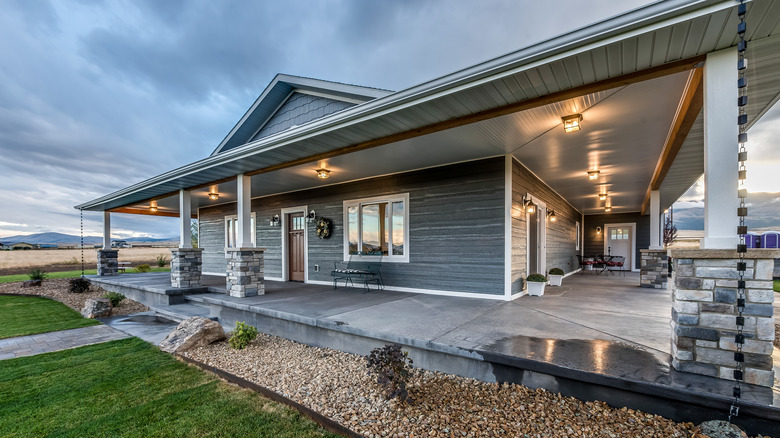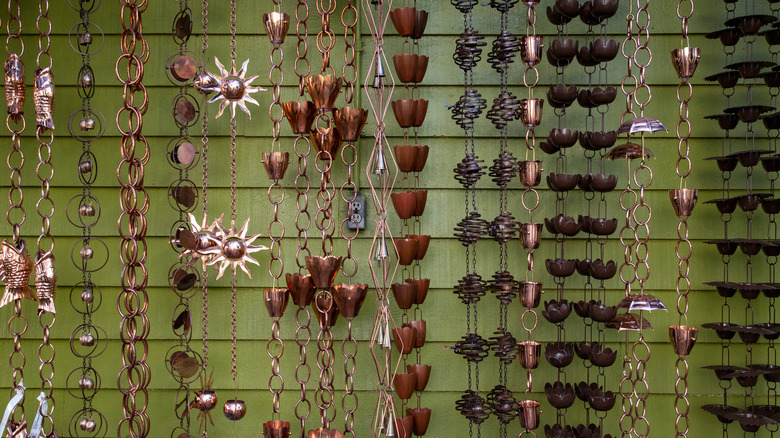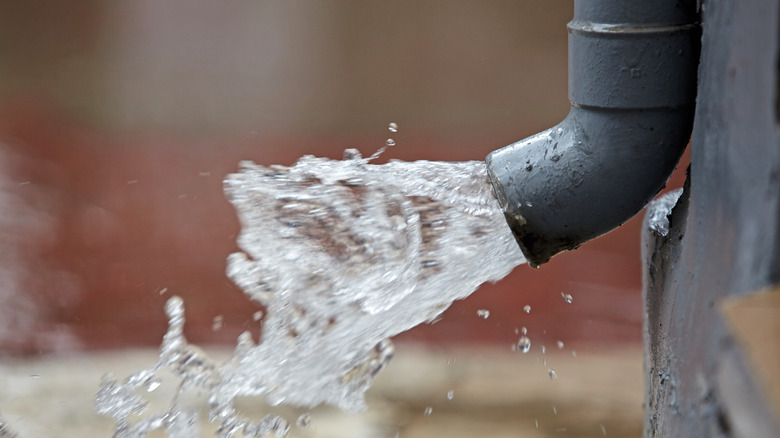Rain Chains Or Downspouts: Which One Is Better For Your Home?
Experienced hikers know to wear water-wicking clothing, so if they get caught in a rainstorm, their shirts and pants move water away from their bodies. That's what a downspout or rain chain does for a house — help remove or relocate water away from the roof and foundation of a house and direct it into the soil, garden, or a water feature. Given that downspouts and rain chains do the same job, which is better for your home?
First, a quick definition of terms: a rain chain, a tradition in Japan for hundreds of years, works with surface tension, per the Clemson Cooperative Extension HGIC. Rain collects on a roof, and water takes the path of least resistance. If rainwater cascading down a pitched roof finds a chain, the water follows it to the ground, slowing the flow as it moves directly downward, leading to less erosion.
Downspouts do the same work. When rainwater and snowmelt run down the roof of a house to a horizontal gutter, a hole punched in the right place is connected to a vertical gutter or downspout. At the bottom, the downspout curves and directs water away from the house. Unlike a chain, a downspout has to be fixed to a building's outside wall with clamps or guards to prevent sway or buckling, according to Angi.
With definitions out of the way, which of these rainfall devices is better for your home: a rain chain or a downspout?
Rain chain advantages
Rain chain or downspout? It's an important decision because the last thing any homeowner wants is a flood in the basement. Deciding to use a rain chain or downspout has a lot to do with weather conditions in your area and the general curb appeal of your home.
Among the reasons why some homeowners might opt for a rain chain versus a downspout is style. As Gardenista notes, chains are decorative and come in many styles and shapes; you can also craft your own. While it's called a rain chain, some links in the device can look like a series of stacked flowers, fountains, or decorative bowls. Also, some rain chains make a sound similar to wind chimes.
Further, chains are comparatively inexpensive to install and tend not to clog as they move water from the roof to the ground. The Hindu reports that sometimes, depending on the configuration of the building, a downspout leads to a rain chain.
Downspout advantages
Between rain chains and downspouts, downspouts offer more capacity when it comes to the amount of rainfall the device can redirect. If you're in an area that sees heavy rainfall, a downspout is most likely the better choice for your home and its roof. This is because a horizontal gutter filled to the brim with water that has nowhere to go will simply overflow. This is the last thing you want for the structure — overflowing water will spill down walls, directly onto the ground, and continue on along into the foundation. When it comes to downspouts, the size and placement are both key to its effectiveness, per Angi.
Alsco, a building products manufacturer, says downspouts come in various sizes, and a gutter system — horizontal and vertical — is actually sized to the dimensions of your house to ensure water can be moved away from the sides and foundation fast enough to prevent damage. Alsco also points out that downspouts match gutters in size and material, and both match the color of the house, a look that many people prefer.
Nevertheless, you might not have to choose between a rain chain or downspout at all. In an episode of HGTV's "Home Town" (via Realtor.com), Erin and Ben Napier devised a way to use gutters for efficiency, but also incorporate a rain chain for aesthetic appeal, demonstrating that the drainage system for your house doesn't have to be one or the other, but can be a practical and attractive combination of both.


